Jobs (BigQuery)
From the Jobs tab, you can access comprehensive information about all the jobs linked to Unravel-monitored projects. You can quickly list the necessary job details if you have a specific job ID. Alternatively, you can use various filters to narrow down and find a specific job from any of the following tabs. Refer to Filtering BigQuery jobs.
All: All the jobs are listed, regardless of the status.
Running: All the applications in running status are listed.
Inefficient: All the applications with inefficient events during their run are listed.
The filters can vary for each of these tabs. For instance, you can only filter the Inefficient list of jobs by the Insights filter. You can also click  in the All and Running tabs to include Unravel's BigQuery jobs to get data about BigQuery usage.
in the All and Running tabs to include Unravel's BigQuery jobs to get data about BigQuery usage.
You can also choose to compare two job runs, identify the problems with the job run that has discrepancies, and then resolve those issues. Refer to Comparing BigQuery jobs.
Filtering BigQuery jobs
You can easily filter the jobs from any options on the left panel. Do the following to filter jobs:
On the Unravel UI, click Jobs.
Select any of the following filters from the left panel. The Jobs are listed on the right based on the filter selections.
The total number of jobs that meet the filtering criteria is shown at the top of the filtered list, along with the date and time when the filter was last updated.

Filters
Description
Creation time
Filters the jobs that are started in the specified period. These can be in the 1 hour, 6 hours, 12 hours, one day, seven days, 14 days, 30 days. You can also specify your custom date range to filter jobs.
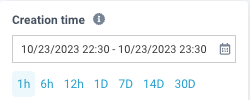
Tags
Select the tags to filter jobs. Click in the Tags > Select box, and the list of available tags is displayed for selection.
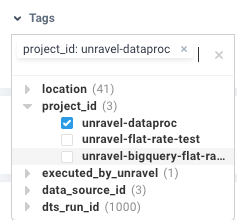
Insights
Select an insight. The jobs attached to the selected insight are displayed.
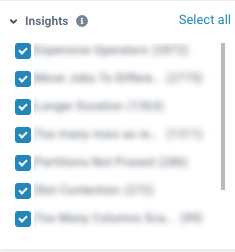
Status
Select a status. The options are All, Done, Running , and Failed.
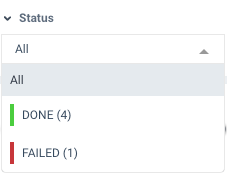
Billed bytes
Use the sliders to set the minimum and maximum values for the billed bytes. The jobs that fall in that range are listed.

Slot time consumed
Use the sliders to set the minimum and maximum values for the slot time consumed. The jobs that fall in that range are listed.

User
Select users to filter the jobs.
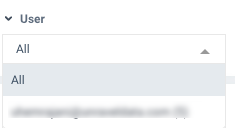
Projects
Select the BigQuery project to filter the jobs.
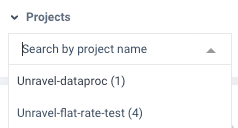
Duration
Select the duration of the job run to filter the jobs.
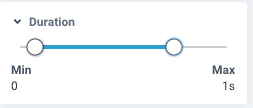
Type
Select the job type, for example, Query or Load, to filter the jobs.

A table with the following columns shows the filtered list of jobs.
Tip
All the columns in the queries list table can be sorted in ascending and descending order.
Specify a keyword in the
 search box, and the queries matching the keyword are immediately listed.
search box, and the queries matching the keyword are immediately listed. Click
 to download the job list in a CSV format.
to download the job list in a CSV format. From
 , you can select the number of query items that you want to be listed on a page. This can be 10, 15, 25, 50 and 100.
, you can select the number of query items that you want to be listed on a page. This can be 10, 15, 25, 50 and 100. Use the pagination
 to move to any of the pages in the job list table.
to move to any of the pages in the job list table.
Job list columns
Description
Compare
Checkboxes are provided in this column to choose two jobs for comparison. Refer to Comparing BigQuery Jobs for more details.
Job ID
The job ID is listed. You can click the link of a job ID to view the job details page for that job.
Statement
The query statement is listed.
Insights
An icon
 is displayed corresponding to the job ID that has an insight. Click the Job ID
is displayed corresponding to the job ID that has an insight. Click the Job ID Type
The type of the job is listed—for example, Query or Load type.
Billed bytes
The bytes billed for a job are listed.
Slot time consumed
The slot time consumed for a job is listed.
user
The users who run the job are listed.
Project
The projects in which the jobs are run are listed.
Creation time
The start time of a job is listed.
End time
The end time of a job is listed.
Duration
The duration for which a job has run is listed.
Same statement jobs
Click the Same statement jobs link to view a list of jobs running the same query statement as the selected job. The job from where you clicked the link is marked as Current.

Comparing BigQuery jobs
Use the compare jobs feature within the Job section to ensure the smooth execution of your jobs while meeting SLAs. For instance, if you get an alert informing you that one of your jobs is taking longer to complete, you can compare the job with another job to figure out the underlying issue and resolve it. In such cases, you can compare the current run with a previous one with a typical duration.
This comparison reveals the discrepancies and differences with the recent run—for example, data skew or significantly larger data inputs. Once you identify the issue, you can make the necessary adjustments.
Note
At a time, you can compare only two jobs, the current one with another.
To compare BigQuery jobs, do the following:
On the Unravel UI, click Jobs.
Select any two jobs from the Jobs table and click the Compare Jobs > Compare button on the lower right.
Note
The Compare jobs page displays the differences because the Show differences toggle is turned on by default. You can turn off the Show differences toggle to check all the job details other than the differences.

You can compare the following aspects of the jobs:
Job details
Project
Insights
Dataset
Data - Sources
Table
Tags
Errors
Metrics

Tip
Click the View job link to view the job details page of that specific job.
Click any links in the upper right section to jump to that specific section and view the comparison details.
Use the Show differences toggle to showcase only the differences between the two jobs or to view all the details.
Note
Alternatively, you can also compare jobs from the Job details page. Refer to BigQuery job details page > Compare jobs.